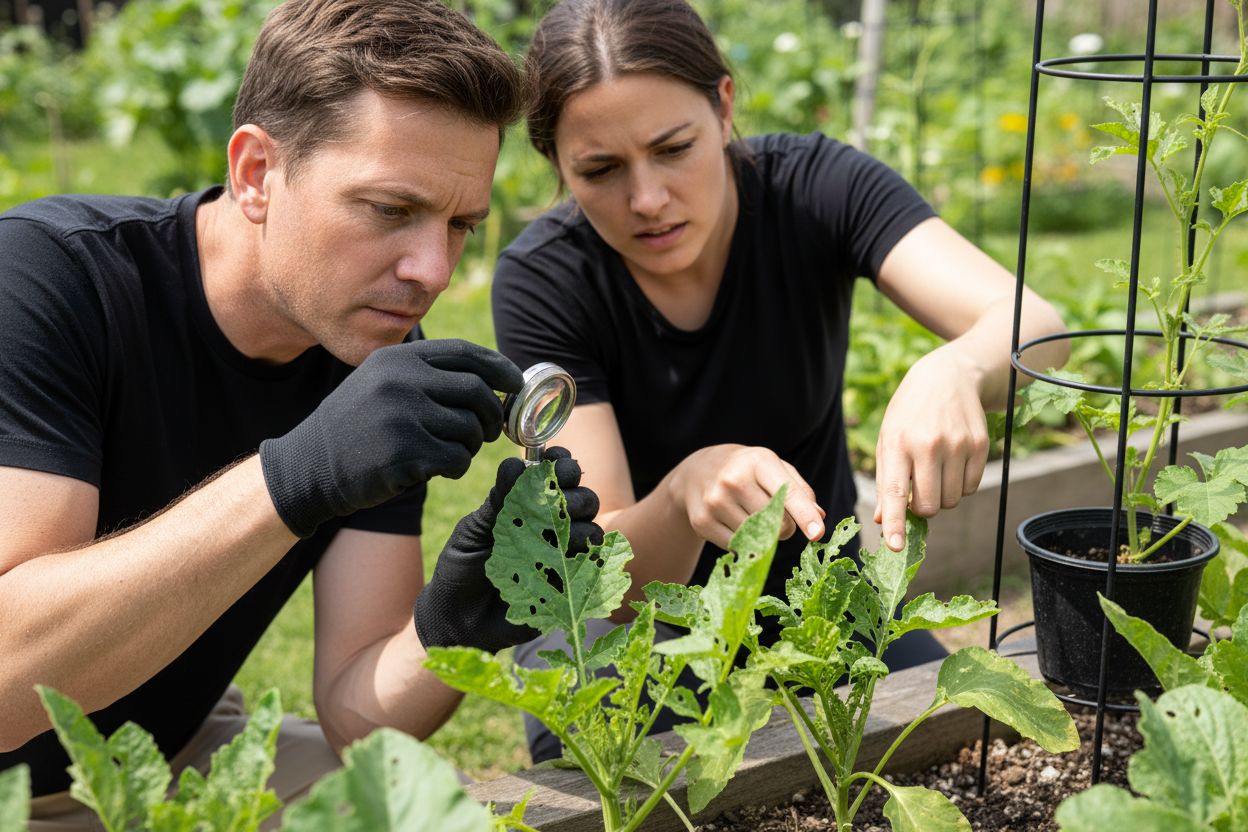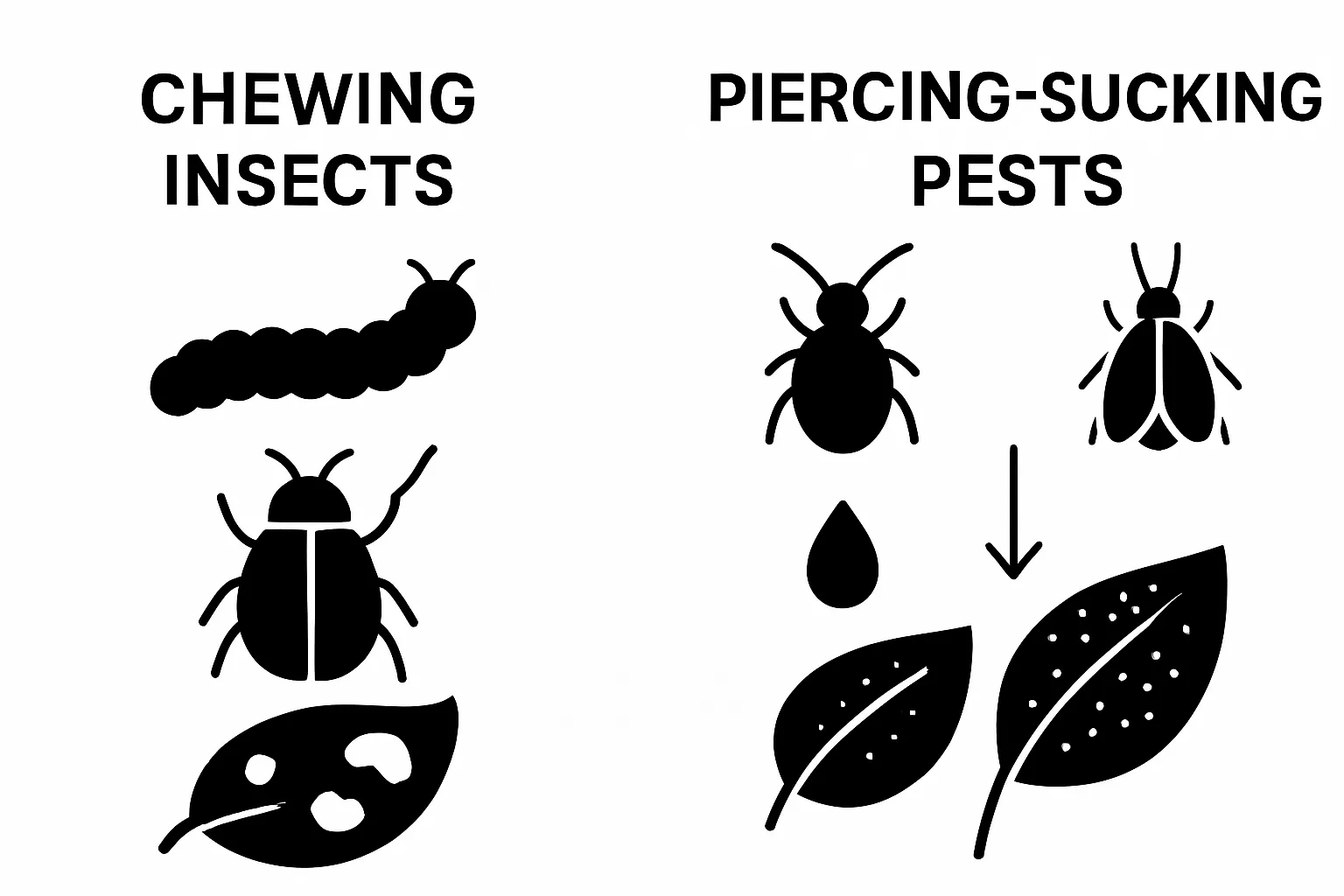Table of Contents
Vegetable gardens promise fresh harvests but come with an invisible challenge lurking in the soil and leaves. Up to 40 percent of garden crops can be wiped out by pests each season and gardeners often never see the culprits coming. The real surprise is that many of the most destructive invaders are tiny and silent and their attacks often get mistaken for natural plant problems instead of the work of expert garden thieves.
Quick Summary
| Takeaway | Explanation |
|---|---|
| Identify pest types early | Early identification helps apply targeted control measures and prevent widespread damage in your vegetable garden. |
| Monitor for damage signs | Recognizing specific damage patterns assists in diagnosing pest problems quickly for effective interventions. |
| Maintain plant health | Robust plant health makes gardens less susceptible to pests, reducing the chances of infestation and damage. |
| Implement preventative measures | Utilizing crop rotation and choosing pest-resistant varieties helps create a sustainable garden ecosystem that deters pests naturally. |
| Use biological pest control | Introduce natural predators like ladybugs to balance pest populations and minimize reliance on chemicals for pest management. |
What Are Common Vegetable Garden Pests?
Vegetable gardens attract a diverse range of pests that can cause significant damage to your carefully cultivated crops. Research from the University of California Agriculture and Natural Resources reveals that understanding these common vegetable garden pests is crucial for maintaining healthy and productive garden spaces.
Types of Destructive Garden Pests
Gardeners encounter several categories of pests that can wreak havoc on vegetable plants. These destructive organisms typically fall into three primary groups:
- Insects: Small but mighty predators like aphids, beetles, and caterpillars
- Mollusks: Slugs and snails that consume plant tissue
- Larger Animals: Rabbits, deer, and rodents capable of extensive crop destruction
Identifying Pest Damage Patterns
Recognizing pest damage early helps gardeners implement targeted control strategies. Different pests leave distinctive marks on vegetation:
- Chewed leaf edges often indicate caterpillar or beetle activity
- Small holes and stippled leaf surfaces suggest aphid infestations
- Completely stripped plants might signal larger animal intrusions
Understanding these patterns allows gardeners to diagnose problems quickly and protect their vegetable gardens. For more comprehensive insights into managing garden challenges, read our guide on natural pest control techniques.
Below is a table comparing common categories of vegetable garden pests and their typical characteristics to help gardeners with quick identification and management strategies.
| Pest Category | Example Pests | Damage Mechanism | Typical Signs |
|---|---|---|---|
| Insects | Aphids, Beetles, Caterpillars | Chewing or sucking plant tissue | Holes in leaves, chewed edges, stippling |
| Mollusks | Slugs, Snails | Consuming leaf and stem tissue | Irregular holes, slime trails |
| Larger Animals | Rabbits, Deer, Rodents | Eating entire plants or large portions | Completely stripped plants, bites at stem base |
| Chewing Insects | Grasshoppers, Beetles | Consuming leaves and stems | Large holes and missing plant sections |
| Sap-Sucking Insects | Aphids, Whiteflies | Extracting plant fluids, disease transmission | Yellowing or curled leaves, sticky residue |
Pests are opportunistic, targeting vegetables when plant defenses are weakened. Factors like poor soil health, inadequate watering, and overcrowded planting can make your garden more susceptible to these unwanted visitors. Maintaining robust plant health serves as your first line of defense against potential pest invasions.
The Importance of Identifying Garden Pests
Identifying garden pests is a critical skill that can make the difference between a thriving vegetable garden and a decimated crop. Scientific research from Cornell University demonstrates that early and accurate pest identification allows gardeners to implement targeted and effective control strategies.
Early Detection and Intervention
Timely pest identification provides gardeners with a significant advantage in protecting their vegetable gardens. By recognizing pest signs early, you can prevent widespread damage and minimize crop loss. Proactive monitoring becomes your most powerful defense mechanism against potential infestations.
Key benefits of early pest detection include:
- Preventing exponential population growth of harmful insects
- Reducing the need for aggressive chemical interventions
- Protecting the overall ecosystem balance of your garden
Understanding Pest Impact on Plant Health
Each pest species interacts differently with vegetable plants, causing unique forms of damage. Some pests directly consume plant tissue, while others transmit diseases or disrupt plant growth processes. Learn more about vegetable gardening fundamentals to develop a comprehensive understanding of plant vulnerability.
Pest interactions can be complex and multifaceted. For instance, aphids not only consume plant sap but can also introduce viral infections that compromise entire plant systems. Understanding these intricate relationships helps gardeners develop nuanced and effective pest management strategies.

Successful garden pest management requires continuous learning, observation, and adaptation. By developing a keen eye for pest identification and understanding their ecological roles, gardeners can create resilient and productive vegetable gardens that thrive despite potential challenges.
How Common Vegetable Garden Pests Affect Your Plants
Research from the National Gardening Association reveals that vegetable garden pests can dramatically impact plant health through multiple destructive mechanisms. These tiny invaders create cascading challenges that compromise plant growth, nutrition, and overall productivity.
Direct Physical Damage Mechanisms
Pests interact with vegetable plants through direct physical destruction, targeting different plant components. Leaf-feeding insects like caterpillars and beetles consume plant tissue, reducing photosynthetic capacity and weakening overall plant structure. Some pests create microscopic wounds that serve as entry points for secondary infections.
Common physical damage patterns include:
- Chewing holes in leaves and stems
- Consuming plant tissue completely
- Creating tunnels or burrows in roots
- Stripping bark from plant bases
Systemic Plant Health Disruption
Beyond visible damage, pests can compromise plant health at fundamental physiological levels. Sap-sucking insects like aphids drain critical plant nutrients, disrupting internal growth processes. Explore our comprehensive indoor plant pest guide to understand broader pest interaction dynamics.
Some pests act as disease vectors, transmitting viral and bacterial infections between plants. These microscopic transporters can introduce pathogens that cause more extensive damage than the pests themselves, creating complex ecological challenges for gardeners.
Ultimately, understanding pest interactions requires recognizing their multifaceted impact. Effective garden management involves monitoring not just visible damage, but the intricate ways these organisms interact with and potentially devastate vegetable plant ecosystems.
Key Types of Common Vegetable Garden Pests
Research from the University of Florida’s Entomology Department highlights the diverse ecosystem of pests that can threaten vegetable gardens. Understanding these different pest categories helps gardeners develop targeted protection strategies for their crops.
Insect Pest Categories
Chewing Insects represent one of the most prevalent pest groups in vegetable gardens. These organisms directly consume plant tissue, causing significant structural damage to leaves, stems, and fruits. Examples include caterpillars, beetles, and grasshoppers that can rapidly decimate entire plant populations.
Key chewing insect characteristics include:

- Ability to consume large amounts of plant material quickly
- Often leaving distinctive hole patterns in vegetation
- Capable of reproducing rapidly under favorable conditions
Sap-Sucking and Piercing Pests
Another critical category includes insects that extract plant nutrients through specialized feeding mechanisms. Piercing-sucking pests like aphids, whiteflies, and spider mites use needle-like mouthparts to drain plant fluids, weakening plant structures and potentially transmitting viral diseases. Dive deeper into plant pest management techniques to comprehend these complex interactions.
These pests often create additional challenges by:
- Secreting honeydew that attracts secondary fungal infections
- Reducing plant photosynthetic capabilities
- Introducing systemic plant viruses
Beyond traditional insect pests, vegetable gardens also face threats from larger organisms like slugs, snails, and small mammals. Each pest type requires unique identification and management approaches, underscoring the importance of comprehensive garden monitoring and proactive protection strategies.
Natural and Sustainable Approaches to Pest Management
According to the Environmental Protection Agency, sustainable pest management represents a holistic strategy that minimizes environmental impact while protecting vegetable garden ecosystems. This approach shifts focus from aggressive chemical interventions to balanced, ecological solutions.
Biological Control Strategies
Biological pest control leverages natural predators and beneficial organisms to manage pest populations. This method introduces or encourages creatures that naturally regulate harmful insect populations without synthetic chemicals. Ladybugs, praying mantises, and certain parasitic wasps act as critical allies in maintaining garden balance.
Key biological control techniques include:
- Attracting beneficial predatory insects
- Introducing natural pest-consuming organisms
- Creating habitat diversity to support ecological balance
Preventative Cultural Practices
Prevention forms the cornerstone of sustainable pest management. Healthy garden ecosystems naturally resist pest invasions more effectively. Explore our comprehensive guide to organic gardening practices to understand foundational prevention strategies.
Effective preventative approaches involve:
- Maintaining robust soil health
- Practicing crop rotation
- Selecting pest-resistant plant varieties
- Implementing companion planting techniques
Sustainable pest management requires ongoing observation, adaptation, and a deep understanding of garden ecosystem dynamics. By prioritizing ecological balance over aggressive interventions, gardeners can create resilient vegetable gardens that naturally resist and manage pest challenges.
The table below summarizes key natural and sustainable pest management approaches, highlighting the strategies and main benefits of each approach for maintaining healthy vegetable gardens.
| Approach | Strategy Description | Main Benefits |
|---|---|---|
| Biological Control | Use natural predators (ladybugs, wasps, mantises) | Reduces chemical use, supports ecosystem |
| Healthy Soil Management | Build robust soil through compost and amendments | Improves plant defenses, deters many pests |
| Crop Rotation | Change plant locations each season | Disrupts pest life cycles, reduces outbreaks |
| Pest-Resistant Varieties | Select plant types bred for pest resistance | Lowers vulnerability, limits losses |
| Companion Planting | Pair plants that deter pests naturally | Minimizes pest attraction, fosters biodiversity |
Take Control of Garden Pests With Expert Guidance From Lushy Gardens
Are you struggling with persistent pests that threaten your vegetable garden’s hard work? Many gardeners face the frustration of chewed leaves, stunted crops, and the uncertainty of identifying which invaders are causing the most damage. If you feel overwhelmed by the challenges of pest management and want to keep your plants strong and healthy, you are not alone. Understanding pest types, learning to recognize their damage early, and using sustainable methods are key steps to reclaiming your garden’s health.
Lushy Gardens makes it easy to turn pest problems into learning opportunities. Explore our Sustainable Gardening advice for nature-friendly ways to protect your crops or discover effective teamwork in plant health by visiting Companion Planting. New to gardening and not sure where to start? Visit our Gardening for Beginners resources for step-by-step help. Let https://lushygardens.com be your trusted partner in transforming your pest worries into gardening wins. Start learning practical strategies and boost your garden’s resilience today.
Frequently Asked Questions
What are the most common vegetable garden pests?
Common vegetable garden pests include insects such as aphids, caterpillars, and beetles; mollusks like slugs and snails; and larger animals such as rabbits and deer.
How can I identify pest damage in my vegetable garden?
You can identify pest damage by looking for chewed leaf edges, small holes, stippled surfaces, or completely stripped plants that signal different types of pest activities.
What are effective natural methods for managing vegetable garden pests?
Effective natural methods include biological control strategies, such as introducing beneficial insects, and preventative practices like maintaining healthy soil, practicing crop rotation, and selecting pest-resistant varieties.
How do pests affect the health of vegetable plants?
Pests can adversely impact plant health by directly consuming leaves and stems, draining vital nutrients, and potentially transmitting diseases, which disrupts overall plant growth and productivity.
Recommended
- Understanding Vegetable Gardening for Beginners: Key Concepts – Lushy Gardens
- Master Natural Pest Control for a Thriving Garden – Lushy Gardens
- Understanding Common Indoor Plant Pests: Causes and Effects – Lushy Gardens
- Companion Planting Guide: Simple Tips for Healthy Gardens – Lushy Gardens
I’m Eleanor, a seasoned gardener with over three decades of experience tending to Mother Nature’s creations. Through Lushy Gardens, I aim to share my wealth of knowledge and help fellow plant enthusiasts uncover the wonders of gardening. Let’s dive into this journey together, one leaf at a time.